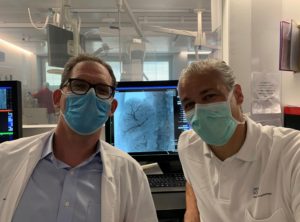
This week, the first patient has been enrolled in the Dragon trials, investigating the safety and feasibility of a novel, double vein embolization procedure in the treatment of patients with colorectal liver metastases.
Resection of liver metastases from colorectal cancer improves survival compared to chemotherapy alone and may lead to cure in up to 40% of patients. If the volume of the future liver remnant post-resection is too low to carry out the surgery, and liver growth needs to be stimulated to reduce the risk of post-procedural liver failure. Portal vein embolization (PVE) is the current gold standard for inducing liver regeneration prior to resection of liver metastases in patients with colorectal cancer. However, the triallists propose that as embolization of both the portal vein and the hepatic vein on one side of the liver leads to “faster and more extensive” liver growth, it could be an improvement compared to PVE.
To test this hypothesis, the investigators are conducting an international, prospective, multi-centre pre-trial—Dragon 1—to explore the safety and feasibility of the double embolization approach, and to test enrolment capacity. All participating centres have to include three patients. Currently, four centres are fully initiated into the study, nine have ethical approval but are not yet initiated, and a further 27 are awaiting ethics approval. Dragon 1 will then form the basis of a randomised controlled trial comparing PVE with hepatic vein embolization (HVE) to PVE alone—Dragon 2. Dragon 2 is expected to start in 2021.
Describing the combined embolization option, the clinicaltrials.gov page for the two Dragon studies notes: “PVE/HVE combines simultaneous embolization of the portal main branches into the tumour-bearing liver and the hepatic vein draining them. The tissue in the part of the liver treated with PVE/HVE stays viable because the hepatic artery continues to supply the liver deprived of portal and hepatic veins.”

Speaking to Interventional News, Christoph Binkert (Kantonsspital Winterthur, Winterthur, Switzerland), the international coordinating investigator for interventional radiology in the Dragon trials, comments: “The first double vein embolization in the Dragon 1 trial went very well. From our clinical experience, we always treat the right portal vein first in order to have good antegrade flow within the portal vein. We used a mixture of Lipiodol [Guerbet] and Glubran [Gem] as an embolic agent. In the same session, the hepatic veins were embolized with Amplatzer plugs. There were two main right hepatic veins and a prominent vein draining segment six, which was also embolized. The patient tolerated the procedure well and left the hospital the same afternoon.”
Earlier preclinical studies in pigs have demonstrated the feasibility of this method, and human case series show accelerated and increased liver growth.
Binkert enthuses: “The Dragon trial is a true international and interdisciplinary trial researching the potential of double vein embolization. The idea is to reach a faster growth of the future liver remnant without additional risks to the patient. After several months of intensive preparation, it is good to finally get started. I am convinced that soon other centres will also start enrolling.”
Binkert spoke to Interventional News last September at the first Embolotherapy (ET) conference in Valencia, Spain (26–29 June, 2019). You can see the full video interview here.











